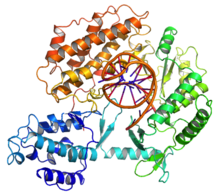
Back تيلوميراز Arabic Telomeraza BS Telomerasa Catalan Telomeráza Czech Telomerase Danish Telomerase German Telomerazo Esperanto Telomerasa Spanish Telomeraas Estonian Telomerasa Basque


Telomerase, also called terminal transferase,[1] is a ribonucleoprotein that adds a species-dependent telomere repeat sequence to the 3' end of telomeres. A telomere is a region of repetitive sequences at each end of the chromosomes of most eukaryotes. Telomeres protect the end of the chromosome from DNA damage or from fusion with neighbouring chromosomes. The fruit fly Drosophila melanogaster lacks telomerase, but instead uses retrotransposons to maintain telomeres.[2]
Telomerase is a reverse transcriptase enzyme that carries its own RNA molecule (e.g., with the sequence 3′-CCCAAUCCC-5′ in Trypanosoma brucei)[3] which is used as a template when it elongates telomeres. Telomerase is active in gametes and most cancer cells, but is normally absent in most somatic cells.
- ^ "What are telomeres and telomerase?". Archived from the original on 2014-05-30. Retrieved 2014-05-30.
- ^ Pardue ML, DeBaryshe PG (2011). "Retrotransposons that maintain chromosome ends". PNAS. 108 (51): 20317–24. doi:10.1073/pnas.1100278108. PMC 3251079. PMID 21821789.
- ^ Cano MI, Dungan JM, Agabian N, Blackburn EH (March 1999). "Telomerase in kinetoplastid parasitic protozoa". Proceedings of the National Academy of Sciences of the United States of America. 96 (7): 3616–21. Bibcode:1999PNAS...96.3616C. doi:10.1073/pnas.96.7.3616. PMC 22343. PMID 10097086.
© MMXXIII Rich X Search. We shall prevail. All rights reserved. Rich X Search